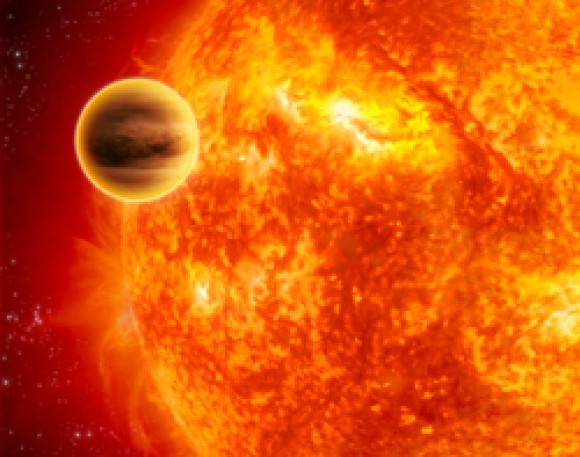[/caption]
Since its discovery in 2008, WASP-12b has been an unusual planet. This 1.4 Jovian mass, gas giant lies so close to its parent star that gas is being stripped from its atmosphere. But being stripped away isn’t the only odd property of this planet’s atmosphere. A new study has shown that it’s full of carbon.
The discovery was published in today’s issue of Nature was led by Nikku Madhusudhan, a postdoctoral researcher at Princeton University in combination with the Wide Angle Search for Planets (WASP) team that originally discovered the planet. Unlike other recent studies of planetary atmospheres, this study did not employ transit spectroscopy. Instead, the team examined the reflective properties of the planet at four wavelengths, observations of which three came from another study using the Canada-France-Hawaii Telescope in Hawaii.
To determine the composition of the atmosphere, the flux of the planet at each of these wavelengths was then compared to models of planetary atmospheres with differing compositions. The models included compounds such as methane, carbon dioxide, carbon monoxide, water vapor and ammonia as well as the temperature distribution of the planet.
For a typical hot Jupiter, models have most closely fit a ratio of about 0.5 for carbon to oxygen which suggests that oxygen is more prevalent in the atmospheres, often in the form of water vapor, as well as very little methane. For WASP-12b, Madhusudhan’s team found an abundance of more than 100 times that of standard hot Jupiters for methane (CH4). When examining the carbon to oxygen ratio, they discovered a ratio greater than one implying that the planet is unusually carbon rich.
While WASP-12b is certainly not a friendly place for life, the discovery of a planet with so much carbon may hold implications for life elsewhere in the universe. Astronomers expect that the abundance was due to the formation of the planet from rocky materials high in carbon as opposed to icy bodies like comets. This suggests that there may be an entire range of carbon abundances available for planets. With the versatility of carbon for forming organic compounds, this enhanced abundance may lead to other, rocky planets covered in tar like substances rife with organics.
The team speculates that such worlds may exist in the same solar system. Previous studies have shown that WASP-12b’s orbit is not circular and some have suggested that this may indicate the presence of another body which tugs on 12b’s orbit.


Thank you for not talking about diamonds.
Hmm… must be because that part of the spectra that shifts between red and blue over time belong to the planet.
I wonder if Sol ever experienced episodic ejections of Carbon and/or Oxygen or other metal….
How is the tiny planet contribution separated from the enormous light from the star in those spectra studies?
@Mana and Aqua: The light from the planet is distinguishable because of how it changes over time. When the planet is between us and the star (even without causing an eclipse), there is little to no light from it. When it’s on the other side, we see the full disc. This comes across as a variation in the total light from the system varying sinusoidally over time with a minimum when the planet is between us and the star, and at a maximum when it’s opposite. I haven’t been able to find a copy of the paper (my writing here was based off the press release and other related studies), but I suspect this is what they were using.
@Aqua: While carbon is present in the Sun’s photosphere, it’s not in any great quantities. Some of it certainly is carried away by CMEs, solar wind, and other such events, but it wouldn’t amount to being able to coat a planet in carbon.
@vagueofgodalming: No problem. Did other news outlets mention it? It was in the press release, but is pretty absurd, so I left it out.
Unfortunately the main t.v. news on the BBC said exactly that – “a planet made of diamonds”. I changed channels.